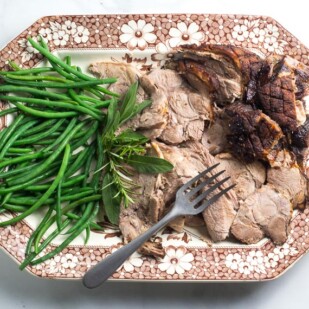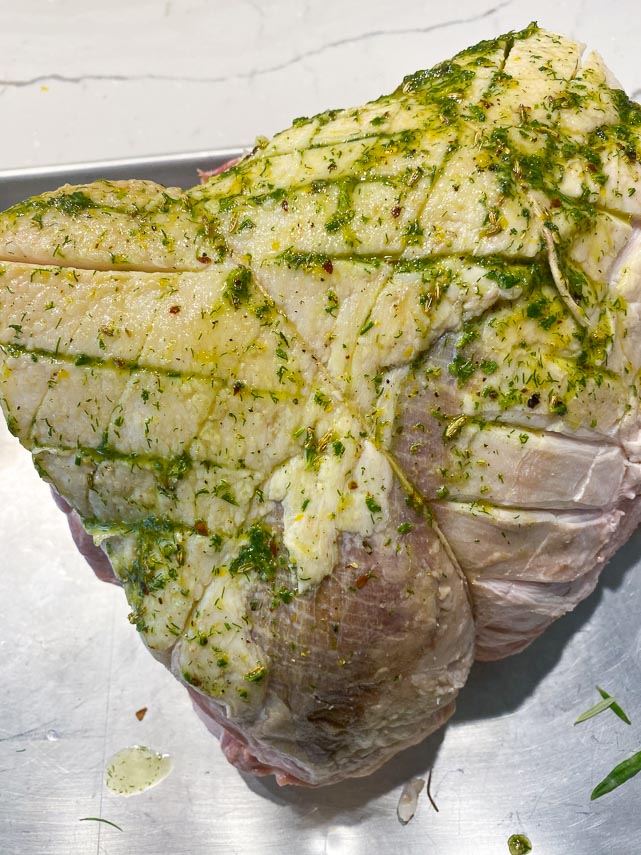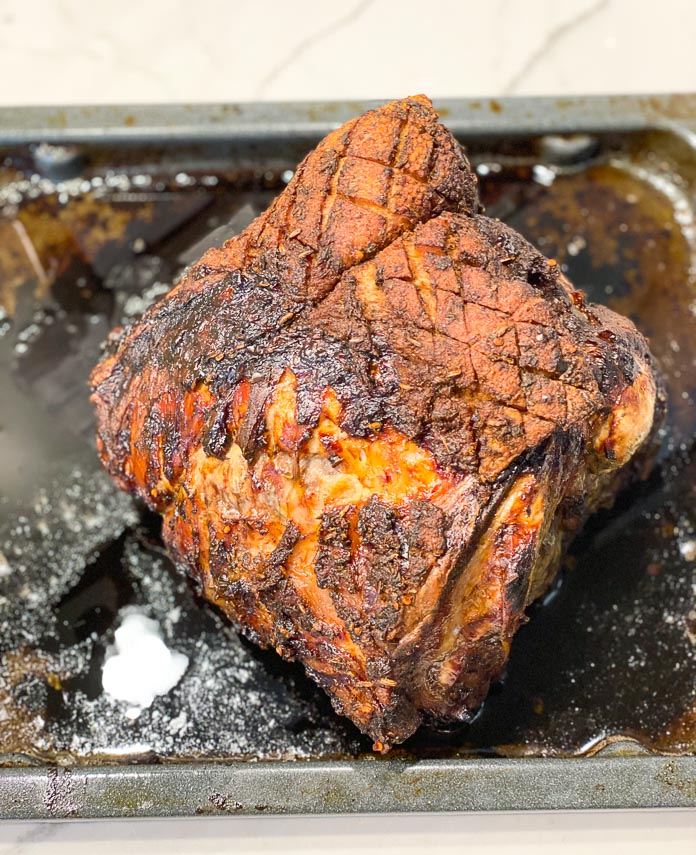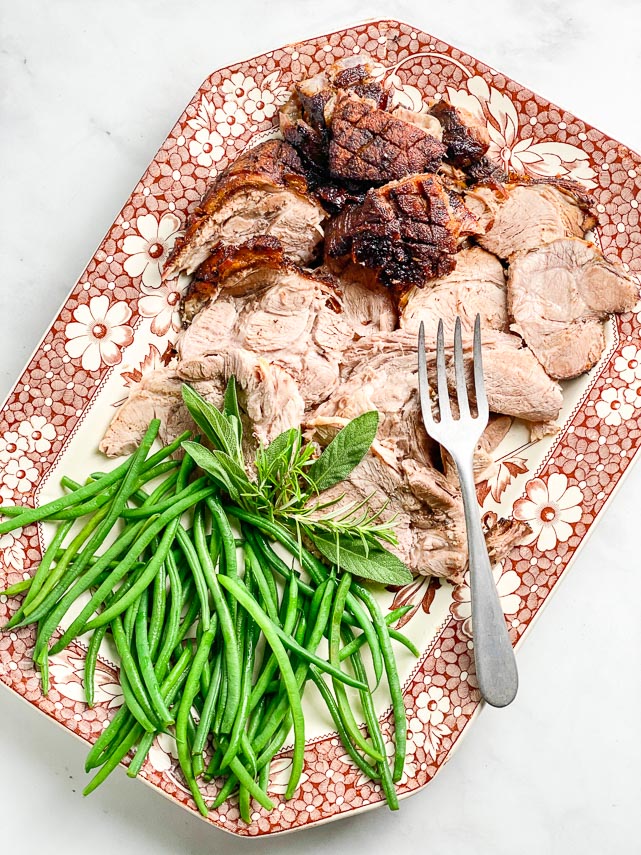Our Low FODMAP Porchetta Pork Roast is an easy-to-make roasted pork shoulder with rosemary, sage, fennel, olive oil, lemon and tons of garlicky flavor. I first tasted this at a potluck and immediately asked who had made it and asked if I could have the recipe. It turns out they had made Melissa Clark’s version from the NY Times. This is our FODMAP IT!™ version. Instead of the original numerous cloves of garlic required, we have used both our Garlic-Infused Oil as well as FreeFod Garlic Replacer.
What Is FreeFod Garlic Replacer?
Possibly the number one thing we hear from folks just learning about the low FODMAP diet is, “What about garlic? How am I going to get along without garlic”?
We always have two kinds of Garlic-Infused Oil on hand – one made with olive oil and one with vegetable oil – and we use scallion and leek greens a lot (low FODMAP), as well as chives (no FODMAP). But if you are looking for more garlic flavor, there is another choice.
FreeFod Garlic Replacer is a powdered product that has a very potent garlic flavor and it is lab tested and certified low FODMAP by FODMAP Friendly.
The garlicky powder is best dissolved in a liquid, so for this recipe we whisk it with a little water and then combine it with all of the herbs, fennel and lemon before combining with the oil to make an aromatic and colorful wet marinade paste. After scoring the pork fat, you rub the paste all over the pork shoulder and refrigerate it overnight.
After this big hunk of meat is roasted you are rewarded with juicy, tender pork fragrant with all of the wet marinade flavors – including that heady hit of garlic.
Ingredients For Low FODMAP Porchetta Pork Roast
The Pork: You might have to order your pork ahead of time, as we did. You can make this with a boneless pork shoulder or bone-in. Boneless cooks faster and I give you directions for each. I usually prefer bone-in for more flavor, but both work beautifully.
Look for about an 8-pound (3.6 kg) bone-in, or a 6- to 7-pound (2.7 kg to 3.2 kg) boneless roast. In either case you want skin and a good amount of fat, about ¼-inch (6 mm) thick.
Fennel: You need fennel fronds, which are the wispy, feathery “leaves” of a fresh fennel bulb, but you do not use the bulb. We love fresh fennel and our salad using the bulb, orange segments and olives would be a fantastic accompaniment to this dish. You will also need fennel seeds. Do not leave them out as they add an immense amount of flavor.
Garlic: We suggest using Garlic-Infused Oil made with olive oil as well as the FreeFod Garlic Replacer. Can you make this without the specialty powdered product? Yes. Will the roast be the same? Nope.
Lemon: You do need a fresh lemon for the zest. Use a rasp style zester to create nice, fine zest.
Fresh Herbs: Your pork is going to cost a pretty penny. Spend the money on fresh rosemary and sage, too. You will be rewarded in the end.
Red Pepper Flakes: Dried red pepper flakes should be in your pantry already; they are, aren’t they?
Kosher Salt & Pepper: We always use Diamond Crystal salt for its flavor and texture and freshly ground black pepper is a must. No pre-ground stuff, folks, which lacks flavor. I LOVE my Peppermate Pepper Mill and use it in our Test Kitchen every single day. It makes grinding large amounts of pepper easy on the hands and wrists.
How To Make Low FODMAP Porchetta Pork Roast
This recipe is easy, but there are several steps that take time. Read this entire recipe through to understand the various steps.
Plan Your Timing
The roast needs to marinate, preferably overnight, so take that into consideration.
Then, it needs to come to room temperature prior to roasting; remove from the refrigerator at least 2 hours before placing in the oven.
Depending on the size of your roast, the oven time might take 3 hours to 4 ½ hours or more of cooking time – and then also you need to figure in a good 20-minute rest.
(The one pictured was bone in and 8 1/2-pounds (3.8 kg) and took just shy of 4 hours at 325°F (165°C), after the initial 35 minutes in a hot oven).
As you can see, most of this is hands-off time, so it is not demanding or difficult.
Prepare The Marinade
Score the fat on your pork shoulder – going through the fat, but not into the meat – and all the flavorful wet paste will infuse the roast with flavor when you press it into the nooks and crannies of the sliced fat.
Make the wet marinade paste: I like to use a food processor fitted with a metal blade, but you could do this by hand and use a mortar and pestle.
This is what fennel fronds look like, just in case you are wondering!
Place the fennel fronds, rosemary, sage, lemon zest, salt, fennel seeds, red pepper flakes and black pepper in your food processor.
Pulse on and off until finely minced and combined.
Stir the FreeFod Garlic Replacer together with water in a small bowl until powder dissolves.

Coat The Meat
The next steps are messy and best accomplished on a large cutting board, rimmed sheet pan or even in a large bowl.
Rub the paste all over the pork, including into the cuts in the fat. I usually start with a silicone spatula and finish with my hands and fingers. Tie it up if you are using a boneless shoulder. Here is the fat cap side.
Here is the underside.
Place in a large bowl (if not in one already), cover with plastic wrap and refrigerate overnight.
You could let it marinate for a shorter time, but I say put in the time! More time = more flavor in the end.
Get Ready To Roast
Take the roast out of the refrigerator for at least 2 hours before you are going to roast it.
Place the roast on a rimmed half-sheet baking pan or large shallow roasting pan. You do not want deep (high) sides. You want low sides to allow maximum exposure to heat.
Roast for 35 minutes at 450°F (230°C), then reduce heat to 325°F (165°C) and continue to roast until an instant-read thermometer inserted into the thickest part (not touching bone) reads 180°F (82°C).
The fat cap will be a rich mahogany brown and very crispy.
Look at all this crispy, cracklin’ deliciousness!
Let the roast rest at least 20 minutes, then DIG IN! Make sure to offer juicy meat AND crispy bits to each lucky diner.
Please note that the nutritional content is based on a 7-pound (3.2 kg) roast and includes hefty servings of the fat.

Low FODMAP Porchetta Pork Roast
Our Low FODMAP Porchetta Pork Roast is an easy-to-make pork shoulder with rosemary, sage, fennel, olive oil, lemon and tons of garlicky flavor. I first tasted this at a potluck and immediately asked who had made it and could I have the recipe. It turns out they had made Melissa Clark’s version from the NY Times. This is our FODMAP IT!Ô version. Instead of the original numerous cloves of garlic required, we have used both garlic-infused oil as well as FreeFod Garlic Replacer.
Low FODMAP Serving Size Info: Number of servings will depend on the size of your roast.
Ingredients:
- About 8-pound (3.6 k)g bone-in, or a 6- to 7-pound (2.7 kg to 3.2 kg) boneless pork shoulder roast, with skin and a good amount of fat, about ¼-inch (6 mm) thick
- ¼ cup (20 g) fennel fronds, from a fresh fennel bulb
- ¼ cup (8 g) fresh rosemary
- 1 ½ tablespoons kosher salt
- 1 tablespoon chopped fresh sage
- 1 teaspoon fennel seed
- 1/2 teaspoon freshly ground black pepper
- ½ teaspoon red pepper flakes
- Zest of 1 lemon
- 2 teaspoons FreeFod Garlic Replacer
- 2 teaspoons water
- ¼ cup (60 ml) Garlic-Infused Oil, made with olive oil, or purchased equivalent
Preparation:
-
Use a sharp paring knife to score the fat into a diamond pattern, as shown in images. Take care not to pierce the meat flesh; set aside.
-
Place the fennel fronds, rosemary, salt, sage, fennel seed, black pepper, red pepper and lemon zest in a food processor fitted with a metal blade and pulse on and off until well chopped and combined. Whisk the water and the FreeFod Garlic Replacer together until the powder dissolves. Pour this into the food processor with it running. Pulse on and off a few times. Now, with the machine on, pour the oil in slowly until you have a thick paste.
-
Use a spatula and/or your hands to spread the wet paste marinade all over the meat and fat, getting into all the slashes in the fat. Don’t leave an inch bare. Place meat in a bowl, cover with plastic wrap and refrigerate overnight. (If you are short on time try to marinate for at least 4 hours).
-
Remove roast from the refrigerator at least 2-hours before roasting. Position rack in middle of oven. Preheat oven to 450°F (230°C).
-
Place the roast, fat side up, on a rimmed half-sheet baking pan or large shallow roasting pan. Roast for 35 minutes at 450°F (230°C), then reduce heat to 325°F (1265°C) and continue to roast until an instant-read thermometer inserted into the thickest part (not touching bone) reads 180°F (82°C). This will be anywhere from 2 hours 45 minutes to 4 hours.
-
Let the roast rest at least 20 minutes. I know it is hard to wait but do it! We love this with mashed potatoes and some sort of green vegetable as a side. Serve the meat and the crispy fat and skin – the cracklings! This is best served when it is made but you will have leftovers to do with what you will. Refrigerate in a covered container for up to 4 days.
Notes:
Tips
FODMAP Information
Our recipes are based on Monash University and FODMAP Friendly science.
- Garlic-Infused Oil: Make your own Garlic-Infused Oil or buy a commercial equivalent for the easiest way to add garlic flavor to your food. Fructans in garlic are not oil-soluble, so garlic-infused oil is low FODMAP.
- Oil: All pure oils are fats and contain no carbohydrates, therefore they contain no FODMAPs.
Please always refer to the Monash University & FODMAP Friendly smartphone apps for the most up-to-date lab tested information. As always, your tolerance is what counts; please eat accordingly. The ultimate goal of the low FODMAP diet is to eat as broadly as possible, without triggering symptoms, for the healthiest microbiome.
Nutrition
All nutritional information is based on third-party calculations and should be considered estimates. Actual nutritional content will vary with brands used, measuring methods, portion sizes and more. For a more detailed explanation, please read our article Understanding The Nutrition Panel Within Our Recipes.
























I ordered my pork shoulder from Whole Foods and specified that I wanted a 1/4 inch fat cap to remain on the cut. Well, I sent my poor father on the errand to pick it up and I unwrapped it to find a practically nude pork shoulder. Ugh! I scored what little fat was left being careful not to cut through to the actual meat and rubbed the marinade all over getting into all the cracks and crevices. My timing was a bit off since my shoulder was boneless, I think, as I found my portion to be a just a bit dry. BUT… my family adored this roast! It received a resounding “thumbs up” from all three generations. Next time I will be sure to reserve the juices from the sheet pan to make a thin au jus to accompany the roast. The meat’s flavor was incredible and a more than acceptable change from the “lantinx” flair of my usual slow roasted pork shoulder. And, I loved how the leftovers warmed up for sandwiches. My fellow low-fodmapers, you MUST give this one a go!
You made me laugh at the “nude” part. YES folks ask your butchers for what you need:) Happy to hear that it was enjoyed by all – and yes, you can get creative with leftovers for this one!
I’m slacking! I forgot to give this recipe it stars.